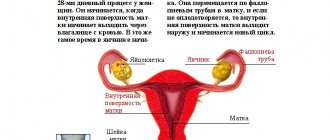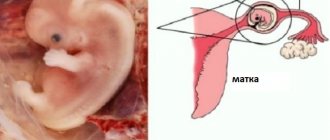Diseases
Many consider the cessation of menstruation to be the first criterion for pregnancy. In most cases, this is how it happens: fertilization of an egg triggers certain processes in a woman’s body that lead to childbirth (and sometimes for some time after it).
But in some cases, menstruation continues until the moment when pregnancy becomes visible to the naked eye - the female body is extremely unpredictable in this regard, so in no case should you focus only on menstruation after conception.
To check pregnancy, it is necessary to use reliable tests, consult a doctor, and if blood appears after pregnancy is clearly established, you should not attribute everything to menstruation - the bleeding may not be harmless at all, which can cause serious problems for the expectant mother. health, up to the forced termination of pregnancy.
Physiological features
The functioning of the body and its systems is subject to certain rules. By the beginning of menstruation, a woman has matured more than 20 thousand eggs in the fertilized egg, one of them moves into the fallopian tube and remains there for ovulation. If conception does not occur, the egg dies and is released along with menstrual blood.
The intrauterine cavity is lined with a functional layer - the endometrium, which grows rapidly after menstruation. Its role is to provide the necessary nutrition to the unborn child, so it is well supplied with blood.
In the absence of conception, the endometrial layer is torn off and comes out, since there is no need to provide nutrients to the embryo.
When fertilization has occurred, the egg is implanted into the endometrium, the hormonal background changes: progesterone is released, and the uterine walls, together with the endometrium, begin to thicken and thicken to reliably protect the embryo.
How does fertilization occur?
To figure out what is the likelihood that menstruation will begin after conception, and how this threatens the fetus, you need to remember your school lessons in anatomy and physiology.
A woman's ovaries contain eggs. Every month, one of them leaves the “storage” and enters the fallopian tube, where it must be fertilized. Then there are 2 options for the development of events:
- If an egg meets a sperm, the zygote (fertilized egg) is sent to the uterus, where it attaches to the inner wall. A signal is sent to the brain that conception was successful. The body begins to rebuild. Immediately after fertilization, there may be changes in hormonal levels. As a result, the process of separation of the inner layer of the uterus (endometrium) stops, since the zygote attaches itself to it.
- The egg does not meet the sperm. Then she dies. The brain receives signals that conception has not occurred, and we need to prepare for the next cycle. Then the egg is destroyed, and the inner layer in the uterus is renewed. In this case, there may be bloody discharge, since it is necessary to get rid of the old endometrium and disintegrated cells. For this purpose, other hormones are released.
Therefore, if fertilization is successful, menstruation should stop, since the endometrium and egg are not destroyed, but are used for their intended purpose. Discharge, on the contrary, should alert you, because it can pose a threat to the fetus. However, there are exceptions to this rule.
Bleeding or menstruation
Menstruation after conception may indicate problems in the body, because normally, with the onset of pregnancy, periods stop. But there are also exceptions.
In the first week of pregnancy, red discharge is possible due to the rupture of the follicle and the release of the egg. Menstruation also occurs at the usual time during conception in the middle of the cycle, when the embryo does not have time to attach to the desired area of the endometrium.
Sometimes two eggs mature at once, one of which is fertilized, and the other, which has died, is released with bleeding. Estrogen deficiency can also cause menstrual periods: due to hormonal imbalance, the expectant mother finds out about her position at 13 weeks.
In any case, such a situation should be a reason for an immediate visit to a medical facility.
If there is a threat of miscarriage, blood is released, but not menstrual blood. The condition is accompanied by discomfort - cramping pain in the lower abdomen or heaviness. Bleeding is preceded by the usual delay of menstruation, as happens during pregnancy, and only at a certain period does discharge appear. In this condition, you must immediately call an ambulance.
With an ectopic pregnancy, bleeding is also present. After ovulation and conception, the zygote is sent to the uterine cavity, but for various reasons it can settle outside of it. This is a reason for surgery.
Pathological bleeding can be distinguished from menstruation by the release of scarlet blood and the intensity of discharge, as well as pain.
How to distinguish menstruation from miscarriage?
It is almost impossible to independently determine whether it is menstruation or a threat of miscarriage. If there is a hormonal imbalance, menstruation may occur during pregnancy; it usually occurs with scanty discharge and only in the first month of pregnancy.
In the absence of any delay, we can assume with almost complete certainty that these are normal periods. But if menstruation was delayed by at least a couple of days, then fertilization and spontaneous miscarriage most likely occurred. A characteristic sign of a miscarriage is heavy and painful bleeding that lasts a long time. The discharge is often bright scarlet, sometimes brownish.
After an early spontaneous abortion, the discharge contains remnants of the fetal bladder in the form of blood clots. If a woman’s general condition is not impaired, then she will most likely refrain from visiting a doctor. If during a miscarriage you experience cramping pain in the lower abdomen, radiating to the lower back, increased body temperature, significant deterioration in health, nausea, weakness, dizziness, then you should immediately go to the hospital. This indicates that the membranes have not completely come out and the woman needs curettage of the uterine cavity.
It is impossible to distinguish a miscarriage from normal menstruation by external signs, and an ultrasound examination a week after fertilization will not give any results. At this stage, the fertilized egg is still too small. A gynecological examination will also not be informative, since palpation and internal examination of the cervix will not allow one to determine the presence of pregnancy. The uterus can be slightly enlarged in any case, both during pregnancy and after a miscarriage.
Causes of menstruation after conception
It happens that a woman is unaware of her situation because her period comes every month. Possible reasons:
- Pathological development of the fetus.
- Hormonal imbalance in the female body.
- Rejection of the egg or endometrium.
- Frozen pregnancy.
- Stressful state of the expectant mother.
- Ectopic pregnancy.
We recommend reading more information about menstruation in the first month of pregnancy.
Implantation
Sometimes menstruation during pregnancy is not dangerous. Implantation of the zygote usually occurs within 2–3 days after fertilization, but sometimes takes up to two weeks. The brain does not receive a signal about conception, and menstruation occurs at the usual time.
Also, a small amount of reddish discharge may appear when the zygote attaches to the wall of the uterus.
Hormonal disorders
Discharge similar to menstruation may occur due to hormonal deficiency. Low progesterone levels, hCG and other metabolic imbalances lead to spotting after conception.
There is a risk of spontaneous abortion. The expectant mother should consult a doctor who will prescribe hormonal medications to preserve the baby.
Cervical injury
After conception, the mucous membranes become loose and vulnerable, and the blood vessels become thinner. Bloody discharge may appear due to injury to the vagina and cervix. This happens after sexual intercourse or a gynecological examination.
Discharge from the genitals is not prolonged and does not pose a threat to the life and health of the child.
Incipient miscarriage
Discharge accompanied by cramping pain in the early stages indicates a threat to the life of the fetus. This means that the fertilized egg has been rejected, died or is close to death. Clots are clearly visible in the discharged blood.
In this case, you cannot do without medical help. If fragments of the embryo remain inside, an inflammatory process will develop, which can be complicated by sepsis. The only way out is surgery.
We also recommend that you read additional information on how to distinguish a miscarriage from menstruation.
Hydatidiform mole
The embryo has a temporary membrane (chorion), which later transforms into the placenta. It can mutate in the uterine cavity, growing into a special tissue similar to clusters with vesicles, which increases in size, resembling a tumor, and sometimes degenerates into a malignant formation. It is impossible to bear a child with such a diagnosis.
To remove the mole, the patient is given anesthesia, the cervix is dilated and the contents are scraped out. As a result of surgical treatment while preserving the reproductive organs, a woman remains able to become pregnant after the menstrual cycle is restored.
Are menstruation dangerous during pregnancy?
If necessary, the doctor will prescribe examinations and tests to rule out spontaneous abortion. If there is a serious pathology, the specialist will insist on terminating the pregnancy. And if bleeding is caused by a lack of hormones, the woman will be advised to take them.
By following all medical instructions, you can avoid miscarriage and be able to carry and give birth to a healthy baby at term.
Can I get my period after conception? All women know the truth - pregnancy occurs - menstruation, or scientifically, menstruation, stops. This happens ideally, but in practice various options are possible. Today in our article we will discuss the topic of whether menstruation can occur after conception and why such periods occur?
For a general understanding of the issue, it is worth shedding some light on the topic of the physiology of the female genital organs during pregnancy.
A non-pregnant woman, from puberty, experiences monthly bleeding from the genital tract – menstruation. This is a completely normal condition, moreover, a sign of normal functioning of the hormonal and reproductive systems.
Each monthly or menstrual cycle lasts from one menstruation to the next and takes from 21 to 40 days. Each woman has her own cycle, and can also change throughout her life. Menstruation is the discharge of blood from the genital tract, which lasts on average from 3 to 7 days. Menstruation is not only blood, but also the remains of the mucous membrane of the uterine cavity - the endometrium, which is rejected at the end of each monthly cycle, as well as mucus and secretions of the uterine glands.
When pregnancy occurs, a rapid hormonal change begins in the body of the expectant mother from the very first days, turning off the processes of egg maturation, cyclical changes in the endometrium, and, of course, the processes of its monthly rejection.
This is very important because there is no period during pregnancy! There are scanty spotting or bleeding of varying intensity, which do not have the right to be called menstruation, but are pathological in nature. Such “menstruation” after conception is most often a sign of a disruption in the normal course of pregnancy.
Based on this, the answer to the question “Can menstruation occur after conception?” - NO. But “Can bloody discharge from the genital tract be observed during pregnancy?” - yes, they can, but this requires the close attention of an obstetrician-gynecologist.
Mechanism of menstruation
To better understand the essence of the issue, you should have a good understanding of how regular periods occur. In the first half of the menstrual cycle, the uterus begins to acquire additional membranes that thicken its endometrium.
During ovulation, a ready and mature egg is released from the follicle on the ovaries into the fallopian tube. If there is a meeting with sperm there, pregnancy will occur. If such a meeting does not take place, the egg will die within a day and descend into the uterine cavity.
- Menstruation
- Ovulation
- High probability of conception
Ovulation occurs 14 days before the start of the menstrual cycle (with a 28-day cycle - on the 14th day). Deviation from the average value occurs frequently, so the calculation is approximate.
Also, together with the calendar method, you can measure basal temperature, examine cervical mucus, use special tests or mini-microscopes, take tests for FSH, LH, estrogens and progesterone.
You can definitely determine the day of ovulation using folliculometry (ultrasound).
- Losos, Jonathan B.; Raven, Peter H.; Johnson, George B.; Singer, Susan R. Biology. New York: McGraw-Hill. pp. 1207-1209.
- Campbell NA, Reece JB, Urry LA ea Biology. 9th ed. - Benjamin Cummings, 2011. - p. 1263
- Tkachenko B. I., Brin V. B., Zakharov Yu. M., Nedospasov V. O., Pyatin V. F. Human physiology. Compendium / Ed. B. I. Tkachenko. - M.: GEOTAR-Media, 2009. - 496 p.
- https://ru.wikipedia.org/wiki/Ovulation
The uterine membranes that have grown during the cycle, in the absence of pregnancy, are simply eliminated from the body in the form of menstrual bleeding as unnecessary. Once pregnancy occurs, everything changes.
Changes in the body after conception
After fertilization of an egg by a sperm, a lot of different processes immediately begin in a woman’s body, designed to help maintain pregnancy. The hormonal background changes, large concentrations of progesterone begin to be produced. This sex hormone prepares the uterus for the upcoming implantation of the fertilized egg; the endometrium of the female reproductive organ becomes thicker and looser. The hormone suppresses the immune system so that it does not accidentally reject the embryo, which is only 50% related to the female body. The child inherits the second half of the genetic material from the father.
Progesterone relaxes the uterine muscles. About a week after fertilization, the blastocyst, which becomes the fertilized egg, descends into the uterine cavity and attaches to one of the walls, in close contact with the endometrium. It practically grows into the wall of the uterus. From this moment, the hormone hCG, human chorionic gonadotropin, begins to be produced. It is this, in combination with high levels of progesterone, that leads to a delay in the next menstruation.
The baby grows and develops in the mother's womb for 38 weeks. Towards the end of the first trimester of pregnancy, hCG levels peak and begin to decline, and progesterone begins to decline closer to childbirth. Actually, its reduction to a certain concentration causes the birth process itself.
For 95% of women, this is exactly what happens. But there are also pregnant women who may not realize their “interesting” situation for quite a long time, since they have menstruation. And only the growing uterus and other symptoms will put everything in its place.
Causes of menstruation after conception
It is quite difficult to consider periods after conception as normal. There is a popular belief that menstruation after a delay is a sign of the so-called “washing of the fetus.” Doctors actually sometimes encounter this phenomenon, and it can be quite difficult to explain.
But normally this happens only once - in the first month of pregnancy. In the future, any spotting will be considered a threat to miscarriage.
A slight bleeding, reminiscent of menstruation, can occur after conception in about two weeks , that is, at the time of the next menstruation if the woman has a bicornuate uterus or in a given cycle two eggs were released from the follicle during ovulation, and only one was fertilized. Next month there should be no such discharge.
If the pregnancy test showed two lines, and the next day or a few days later the woman began menstruation, this may indicate not only the release of a second, “unnecessary” dead egg, but also that the fertilized egg could not implant normally and is rejected. There can be many reasons: chromosomal pathologies of the embryo, which made its further normal development and growth impossible, exposure to toxins, gynecological diseases, which include endometriosis and other inflammatory and infectious ailments.
Even more interesting:
Unidox solutab treatment
Eggworm photo of a child
The cause of unscheduled periods after conception may be a disruption in a woman’s menstrual cycle. If ovulation occurs late, then it is possible that implantation has not yet been completed when menstruation arrives. This happens very rarely, but a woman should know about this possibility.
However, in most cases, a woman mistakes other discharge for menstruation, which is also bloody in nature. There are some situations in which, after fertilization has taken place, a woman may experience such discharge.
Implantation
On the 7-8th day after ovulation, a woman may begin to experience a slight bloody or sanguineous spotting. It does not speak of pathology, but rather is the very first sign of pregnancy a week before the delay. During implantation of the fertilized egg, the integrity of the endometrium is disrupted, which may manifest itself as minor and mild bloody or yellowish discharge. At first, a woman may well mistake this phenomenon for an early onset of menstruation and think that a “failure” of the cycle has occurred.
Washing the fetus
Delayed menstruation is one of the main signs of pregnancy, but sometimes in the early stages a woman’s cycle does not stop. Doctors call this condition ablution of the unborn child. How do menstruation progress through a fetus? Usually they are no different from normal menstruation. This is not a pathology; menstruation during pregnancy is diagnosed in every 5 women.
If, while maintaining the menstrual cycle, signs of early toxicosis appear, then this is a reason to take a pregnancy test. If it turns out to be positive, then the woman should rush to the doctor, since menstruation through the fetus can in some cases be dangerous.
conclusions
There is no normal period after conception. Any bleeding is a reason for prompt examination by a qualified doctor and a thorough examination. It is incorrect to call bleeding during pregnancy menstruation. And any bleeding, with the exception of implantation bleeding, is an alarming sign.
That is why a woman needs to more closely monitor her menstrual cycle, know its features, and monitor the regularity of her periods, even if she is not currently planning a pregnancy.
You need to regularly (at least once a year) visit a gynecologist and get tested for hormones.
If there is confidence that conception was successful, tests have confirmed that pregnancy has occurred, any unusual discharge will be considered abnormal and unacceptable. And the exact cause will be helped to establish and eliminate them, if possible, by an experienced doctor.
For information about what happens in the first 2 weeks after conception, see below.
medical reviewer, psychosomatics specialist, mother of 4 children
The sudden cessation of menstruation in a woman of childbearing age is considered to be the main sign of pregnancy. Anatomy textbooks confirm: when fertilization is successful, a corresponding signal is sent to the brain, hormonal levels change, the body is rebuilt, and as a result, critical days do not come for the next 9 months. However, medicine knows of cases when a girl found herself pregnant, but at the same time she continued to menstruate. So can you get your period after conception? Or are these situations simply the exception to the rule?
What if it's a miscarriage?
If the fact of pregnancy is confirmed and bleeding occurs, you should consult a doctor immediately. This condition is not normal, and in the case of an unconfirmed diagnosis - miscarriage according to ultrasound results, it is recommended to take an additional test for hormones. Inflammatory processes in the body are possible.
If there are hormonal disorders, then in the first two months of pregnancy normal menstruation may occur, but the discharge is insignificant and short-lived.
During a miscarriage, cramping, severe pain appears along with the usual bleeding during scheduled menstruation. To save the baby’s life, an ambulance must be called as quickly as possible. While waiting for her, lie down without making unnecessary body movements.
Changes in the body after fertilization
Usually, 2-3 days are enough for a fertilized egg to travel from the fallopian tubes to its implantation site. But sometimes the process takes a little longer - up to two weeks. In the case of conception before menstruation (which does happen due to the specifics of a particular woman’s cycle and contrary to popular belief that this is impossible), the egg simply does not have time to attach itself, and the brain does not have time to receive a signal about the beginning of pregnancy. In this situation, critical days may well come at the appointed time.
When the zygote has already grown to the wall of the uterus, and the placenta is activated, due to increased synthesis of progesterone in the body, a change in hormonal levels is observed. It entails a number of other processes, including the cessation of menstruation. However, there is such a thing as “implantation bleeding.” This is minor spotting that is an early sign of pregnancy. They arise due to damage to the blood vessels at the time of attachment of the fertilized egg to the wall of the uterus. Many women easily confuse this type of discharge with the onset of menstruation.
During pregnancy
In more significant periods of pregnancy - 7-16 weeks - bleeding from the genital tract is the first and main sign of the onset of miscarriage. This is called a threatened spontaneous abortion, a spontaneous abortion that has begun, or an abortion in progress, depending on the intensity of the bleeding and the presence of signs of life in the fetus.
Such bleeding does not occur due to rejection of the uterine mucosa, but due to detachment of the fertilized egg or chorion from the uterine wall, rupture of the feeding vessels and the formation of blood accumulations or hematomas.
In pregnancy periods over 16 weeks, when the placenta or baby's place has finished developing at the site of implantation of the fertilized egg, bleeding from the genital tract is a sign of detachment of this placenta from the uterine wall. This is one of the most dangerous complications of pregnancy. At such a time, bleeding becomes dangerous not only for the fetus, but also for the woman herself.
In the third trimester, bleeding from the genital tract can also occur due to damage to the umbilical cord vessels in the fetus or their separation from the placenta.
Causes of menstruation after conception
As we have already found out, the two most common reasons for the arrival of critical days after fertilization of the egg are the incomplete process of implantation of the fertilized egg into the endometrium of the uterus or the immediate period of implantation of the blastocyst. Also, menstruation after conception may occur due to:
- Hormonal imbalances, when the so-called. progesterone deficiency, poorly produced estrogens, or an excess of androgens. In such cases, the body is simply unable to “recognize” pregnancy, so menstruation continues as usual for some time.
- The simultaneous maturation of two eggs in each ovary, one of which meets the sperm (i.e., fertilization occurs), while the second dies and is released naturally.
- “Color pregnancy” is a rather rare phenomenon in which for several weeks, or even months, menstruation continues to occur after fertilization of the egg. But in this case, there are no symptoms characteristic of the beginning of critical days: swelling of the body, breast enlargement and increased sensitivity, nagging pain in the lower abdomen, changes in the emotional background.
In addition, spotting can be caused by cervical erosion; this is no longer menstruation, but bleeding. In such a situation, a gynecological consultation will be needed to prescribe the correct treatment without the risk of threat to the fetus. Short-term bleeding, which women mistake for scanty periods, can be triggered by a gynecological examination, sexual intercourse, or douching. Among other factors, doctors name colds, severe shocks and stress, and overexertion. In any case, only a doctor can determine the exact cause of menstruation during pregnancy.
When, after conception, the endometrium of the uterus peels off and bleeding begins, we can talk about the following pathologies:
- spontaneous miscarriage;
- ectopic, frozen, incorrectly developing pregnancy;
- anomalies in the structure of the uterus, in which it is not possible to carry the fetus to term, since the embryo is attached in places with weak/absent blood supply;
- placental abruptions, placental presentation;
- endometriosis, benign neoplasms of the endometrium, myometrium;
- genetic pathologies in the mother or embryo, etc.
ECO
You need to understand that pregnancy achieved with the help of assisted reproductive technologies (IVF, ICSI, insemination) itself is not entirely common. The early stages of such pregnancies take place under the guise of various hormonal drugs and a special regime. Bloody discharge during such “test tube” pregnancies can sometimes appear and require adjustment of maintenance therapy.
Summing up the results of our article, I would like to say that if a woman becomes pregnant and during pregnancy her periods begin, it is necessary to consult a doctor and find out the reasons for such deviations.
Hormone levels when the endometrium of the uterus sloughs off and bleeding begins. This occurs in cases where conception has not occurred. If they arrived after the fertilization of the egg, then we can assume that the same thing is happening. But a drop in hormones is the first sign of a miscarriage. Therefore, even with a small amount of bloody discharge, you should consult a doctor as soon as possible. The sooner this is done, the higher the chance of saving the child.
How to identify pathological disorders
In early pregnancy, it is almost impossible to distinguish normal periods from bleeding - evidence of the development of a pathological process. Therefore, a woman should be extremely attentive to the slightest alarming symptoms that signal a danger to the fetus and the expectant mother herself. Among them:
- abundance of discharge;
- blood is bright scarlet;
- excessive pain in the abdominal area, the nature of which can range from acute to nagging;
- increased heart rate;
- jumps in body temperature;
- general weakness;
- nausea, vomiting;
- dizziness, migraine, etc.
If you notice such symptoms, you should immediately consult a doctor. After all, spotting, which is accompanied by cramping pain, can indicate the onset of a miscarriage, and only calling an ambulance can save the pregnancy. Before the doctors arrive, you must take a horizontal position and try to eliminate unnecessary body movements.
Physical signs of pregnancy during your period
A normal menstrual cycle lasts 28-30 days. Ovulation occurs on days 13-14 of the cycle. If unprotected sexual intercourse occurs during this period, there is a high probability that pregnancy may occur. But many women know that not everyone has a perfectly correct cycle, and this process is influenced by many factors:
diet;
intense sports activities;
stress;
ecology;
climate change.
During the entire menstrual cycle, the female body experiences constant changes in hormonal levels.
It is hormones that cause PMS symptoms in a woman’s body, which sometimes resemble the first signs of pregnancy. In both cases, the woman will feel enlargement and heaviness in the mammary glands, but during menstruation it goes away with the appearance of discharge, and during pregnancy it remains for a long time. There may also be nagging pain in the lower abdomen that spreads to the lower back. Disturbances in the functioning of the gastrointestinal tract can also occur both during PMS and in the early stages of pregnancy. PMS and early toxicosis are characterized by nausea, vomiting, and dizziness.
As a result of a strong rush of blood to the pelvic organs, a woman may feel an increased urge to urinate. Under the influence of hormones in the body, a change in taste preferences occurs, when the fair sex herself does not know what she wants more, chocolate-covered herring or pickled cucumbers.
To confirm or exclude pregnancy, you need to pay attention to the presence of internal signs of pregnancy.
When should you consult a doctor?
How dangerous the critical days after conception can be is difficult to determine at first glance. Not all bloody discharge poses a threat to the lives of mother and baby. Sometimes menstruation occurs due to hormonal disorders that can occur in the female body in the early stages of pregnancy. In this case, they are of a spotting nature and are not accompanied by pain.
However, if the intensity and duration of bleeding is similar to the usual menstruation, this is the first sign of a possible termination of pregnancy. Excessively painful bleeding can also be a harbinger of a similar outcome.
If menstruation begins after conception, regardless of whether it is scanty or heavy, the pregnant woman needs to urgently consult a gynecologist. Independent attempts to cope with bleeding using medications or folk remedies can result in serious health problems, including spontaneous miscarriage.
To establish an accurate diagnosis, the doctor will prescribe a number of studies, including:
- Ultrasound diagnostics to detect the presence of a fertilized egg in the uterus.
- Blood chemistry.
- A test that determines the level of human chorionic gonadotropin, etc.
How to distinguish between periods during pregnancy and the onset of a miscarriage?
If the fact is confirmed, and the bleeding continues, you should immediately run to the doctor. In any case, this cannot be called the norm. Even if he does not confirm a miscarriage during examination on a chair and ultrasound, it would be useful to donate blood to determine the level of hormones and inflammatory processes.
Normal menstruation, which occurs due to hormonal disorders that can occur in a woman’s body in the first months of pregnancy, is insignificant and is not accompanied by pain. If bloody discharge begins, accompanied by cramping pain in the lower abdomen, then this may indicate the beginning of a miscarriage and in this case, only calling an ambulance can save the child’s life; before their arrival, you need to take a horizontal position and stop making unnecessary movements.
No. Only non-pregnant women can menstruate.
In pregnant women, the level of prolactin in the blood increases, and because of these hormones, the body switches to a different “mode” of operation. In this new “regime”, eggs stop maturing in the ovaries and hormones are not produced as before.
As a result of all these changes, she also begins to work in a new way: now she has the task of protecting the unborn child. In the uterus, the processes of growth and rejection of the endometrium, which are responsible for the onset of menstruation in each month, stop. The menstrual cycle stops and does not occur.
I'm pregnant, but I got my period - what does this mean?
As mentioned above, pregnant women cannot menstruate. But instead of them, bloody vaginal discharge may appear, reminiscent of menstruation. Such discharge can be as heavy as menstruation and last for the same number of days, which can mislead you. About one in four pregnant women may experience spotting in early pregnancy.
How to distinguish regular periods from spotting during pregnancy?
The difficulty is that spotting can occur on the same days as your period, it can be the same as your period, and even last the same number of days as your period. Therefore, if you have had unprotected sexual intercourse, or errors in taking it, then the arrival of your period on the scheduled days is not a guarantee that you are not pregnant. You need it anyway.
This time my periods were not the same as usual. Does this mean I'm pregnant?
If you are sexually active, and especially if you are not using protection, then any change in the nature of your menstruation may indicate that you are pregnant. The likelihood of pregnancy is quite high if:
- Your period arrived 2-7 days earlier than scheduled
- My periods were not as heavy as usual (fewer pads were used)
- Periods had an unusual color (pink, light brown, brown, black)
- Your period lasted fewer days than usual
Important: interrupted sexual intercourse, when the partner does not put on a condom but removes the sexual organ from the vagina before ejaculation, is not a reliable means of protection against pregnancy and is equivalent to unprotected sex. That is, you can become pregnant as a result of PPA.
The pregnancy test shows two lines, but my period has arrived. What does it mean?
If the test shows two lines or confirms pregnancy, then there is a pregnancy and the appearance of spotting does not cancel the results of tests or analyses.
Every fourth woman experiences bloody vaginal discharge in early pregnancy. In about half of these women, spotting does not threaten pregnancy and does not indicate that something is wrong. But for the other half, spotting is a sign of miscarriage. This is why you need to pay close attention to this discharge and see a gynecologist to make sure everything is okay.
When is spotting during pregnancy not dangerous?
Bloody discharge in early pregnancy is not as uncommon as it might seem at first glance. Many women turn to a gynecologist about this. Sometimes these discharges do not threaten pregnancy and are associated with changes in the body during pregnancy:
- Implantation bleeding
- Bloody discharge associated with sexual intercourse
- Bloody discharge associated with examination by a gynecologist
What is implantation bleeding?
Implantation bleeding occurs in approximately 20-30% of pregnant women. Implantation is the process of attaching an embryo to the wall of the uterus.
During implantation, the blood vessels of the uterus can be damaged, which leads to the appearance of spotting from the vagina of varying degrees of intensity. Sometimes it's just a few pink spots on your panties, sometimes it's a dark spotting that lasts for days.
When does implantation bleeding occur?
Implantation bleeding can occur 7-14 days after conception. Most often, spotting appears a few days before the expected menstruation, but it can also appear on the days when menstruation is due, and even after a period is several days late.
I'm bleeding lightly and now I feel like my period is coming.
If you are planning a pregnancy and suspect that the spotting may be implantation bleeding, then do not worry if you experience symptoms of the onset of menstruation (pulling pain in the lower abdomen, breast swelling). Early signs of pregnancy are very similar to early signs of menstruation, so you still have a chance of being pregnant. To find out for sure if you are pregnant, take a test. This test can be taken as early as 11 days after unprotected sexual intercourse. But a pregnancy test will not help here - it’s too early to do it.
I'm pregnant and after sex I got my period (bloody, brown discharge). Is it dangerous?
Symptoms of ectopic pregnancy:
- the appearance of bloody discharge from the vagina
- sharp pain in the lower abdomen or side
- fainting, headache, pale skin and rapid pulse are signs of internal bleeding
- nausea, vomiting
What is a miscarriage?
A miscarriage is a spontaneous termination of pregnancy, or spontaneous abortion. Approximately 15-20% of all pregnancies end in miscarriage before 12 weeks. Symptoms of miscarriage:
- bloody vaginal discharge
- cramping pain in the lower abdomen (usually stronger than during menstruation)
- vaginal discharge in the form of lumps or pieces of tissue
Most miscarriages cannot be prevented. A miscarriage is the body’s reaction to an abnormal pregnancy, or to a stop in fetal development. (). Having a miscarriage does not mean that you are unhealthy or that you will not be able to have children in the future. The most common cause of miscarriage is fetal pathology. That is, the body gets rid of the fetus, which will die sooner or later, or has already died.
What should you do in such a situation?
See a doctor or call an ambulance immediately.
What is a hydatidiform mole?
Hydatidiform mole is a dangerous complication of pregnancy in which there is no embryo in the uterus, or only individual tissues of the embryo are present. Hydatidiform mole can degenerate into a malignant tumor, chorionepithelioma, which is life-threatening for a woman.
Symptoms of hydatidiform mole:
- bloody
- nausea and vomiting
- very high hCG levels that do not correspond to the gestational age
- Absence of fetal heartbeat on ultrasound
What should you do in such a situation?
Contact your doctor immediately.
Collapse
Many processes in the female body are regulated by hormones. Menstruation begins when conception does not occur and the level of certain hormones decreases, a section of the endometrium sloughs off and bleeding begins. This happens if conception does not occur. Can I get my period after conception? If your period appears after the fertilization of the egg, this may mean that a drop in hormones is caused by an incipient or completed miscarriage. Therefore, in order to maintain the pregnancy, a visit to the doctor cannot be postponed.
Doctors' opinion
Menstruation after conception, in its usual sense, can occur in the first month after fertilization has occurred. It goes away for a short time, and the discharge itself is not abundant. Spotting that appears in the first days after conception should not cause alarm. It is simply evidence of embryo implantation.
It happens that critical days continue to come regularly during pregnancy. If the girl’s well-being is not satisfactory, and there are no abnormalities in the development of the fetus, medicine attributes this phenomenon to the body’s memory, thanks to which the usual hormonal levels take place. It is worth understanding that these cases are rare.









